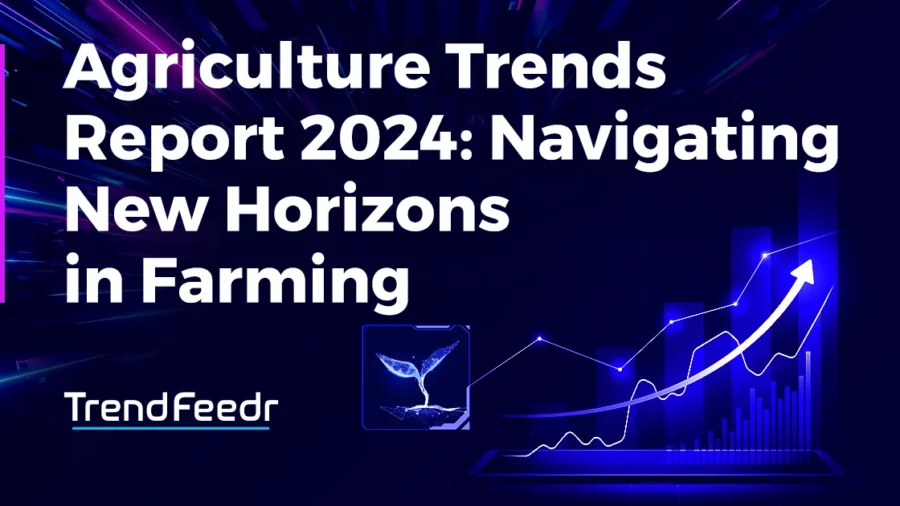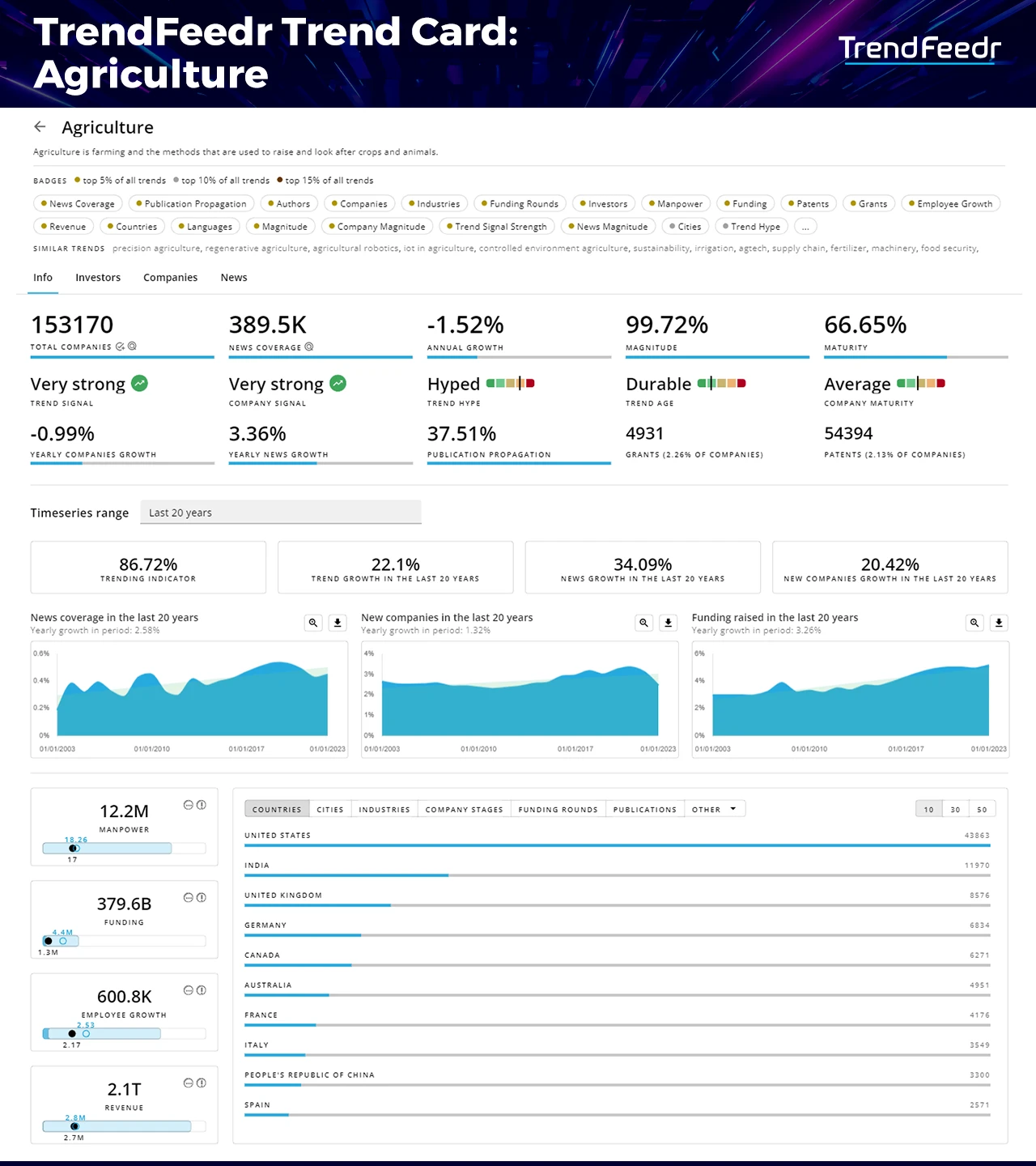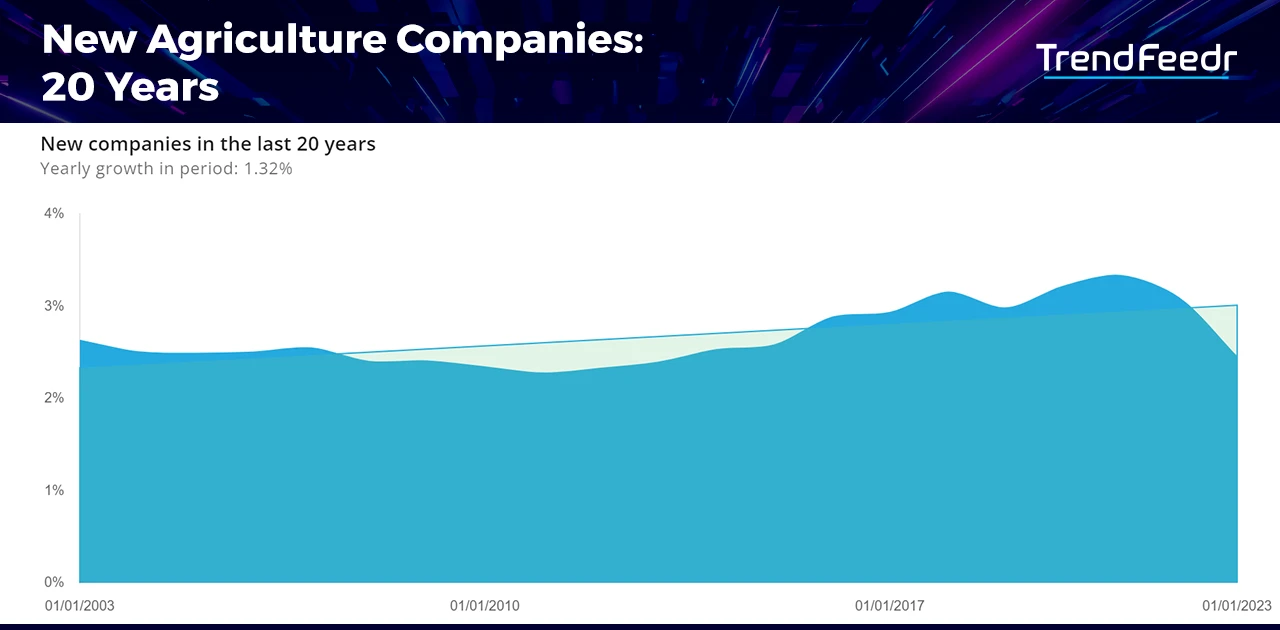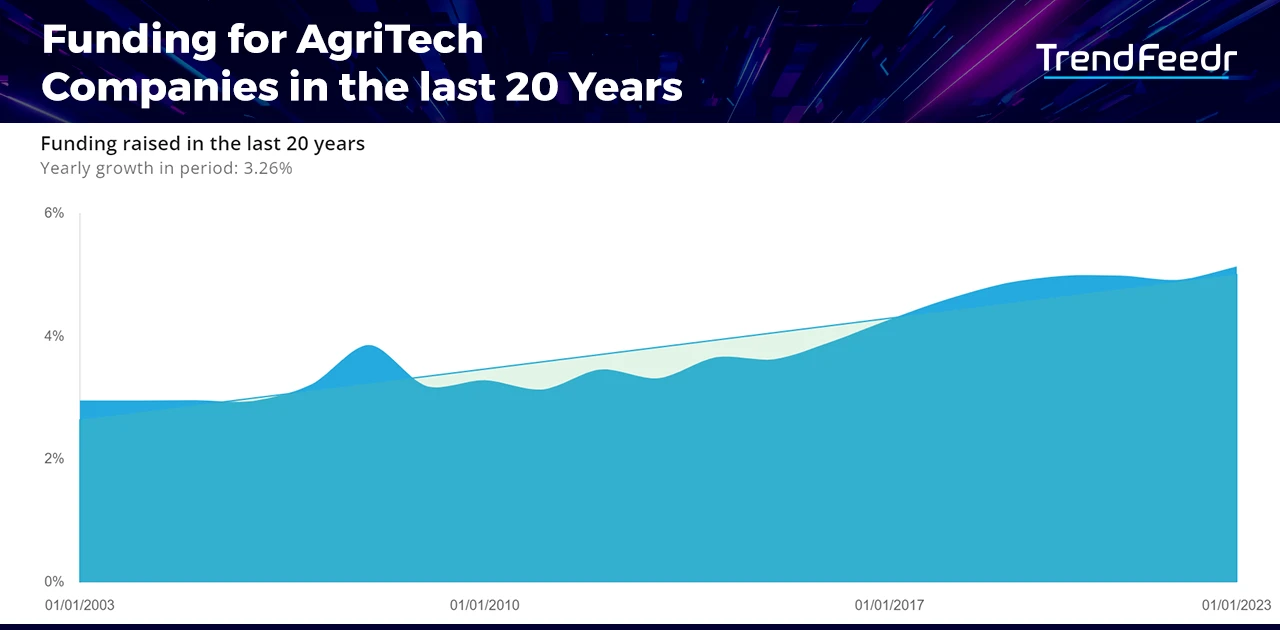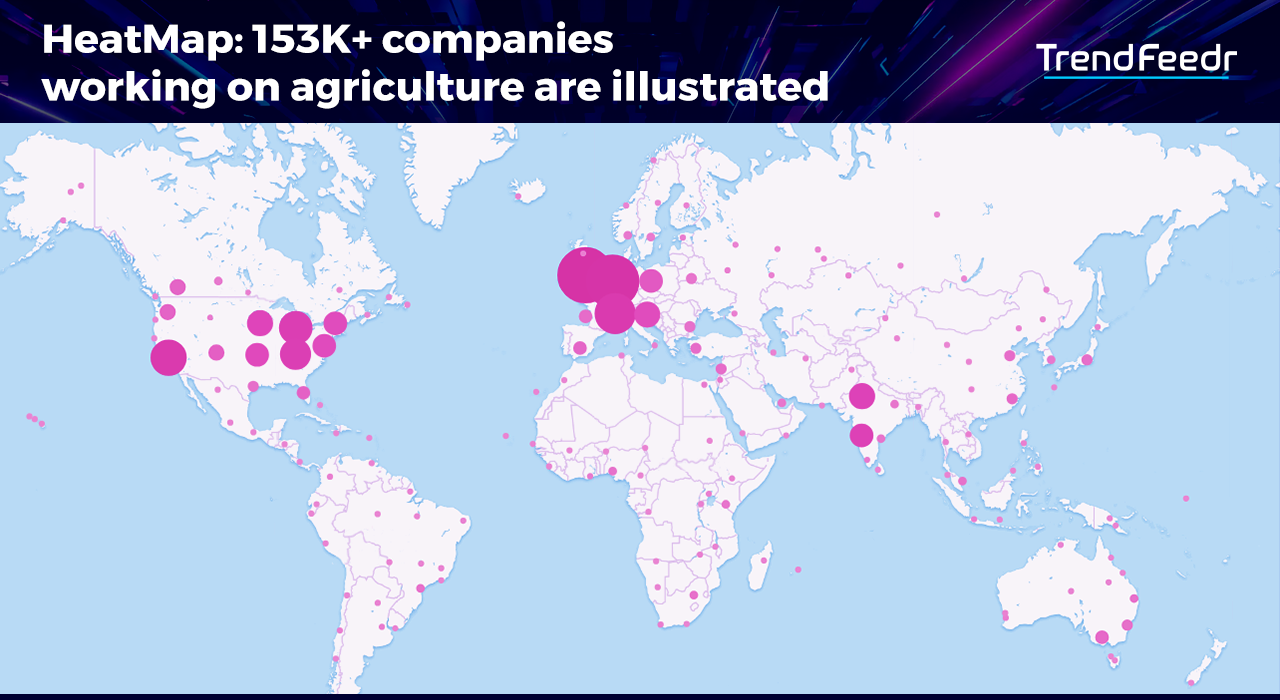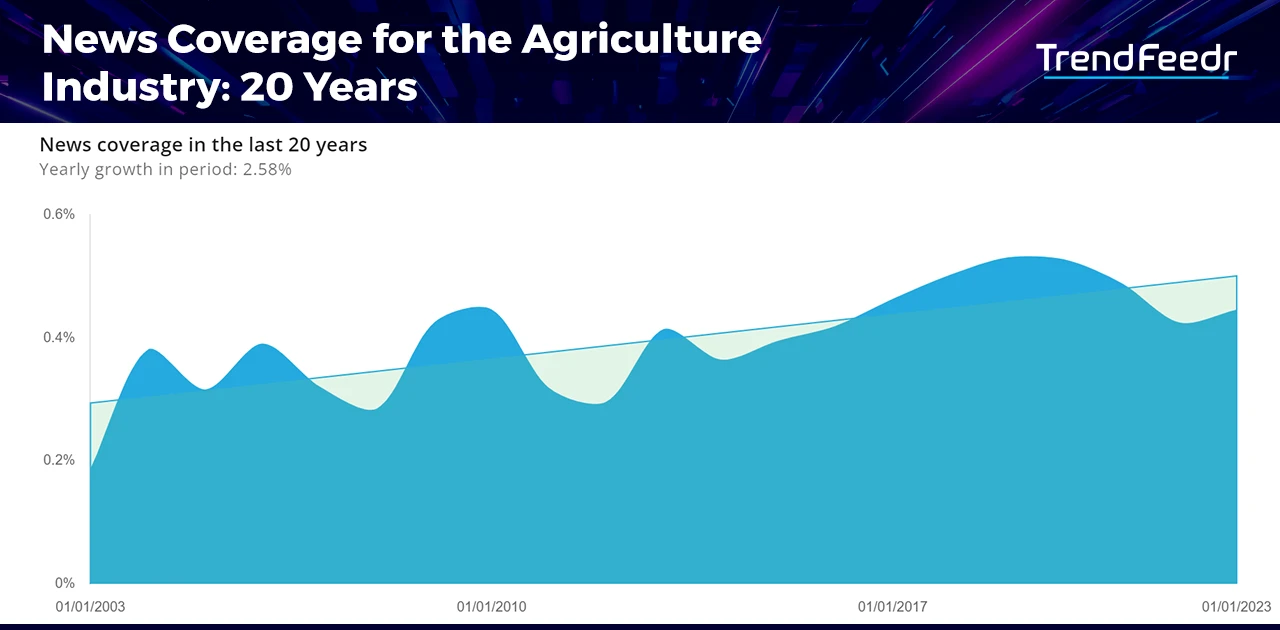In the face of mounting challenges such as climate change, water scarcity, and soil degradation, the agriculture industry is proactively responding. By harnessing technological advancements from precision agriculture and the Internet of Things (IoT) to AI-driven crop analytics, the industry is striving to overcome these obstacles.
With the global population on the rise, this proactive approach becomes even more critical. The United Nations Food and Agriculture Organization (FAO) projects a need for a 70% increase in food production by 2050. This agriculture trends report explores the surge in agricultural innovations. These developments are enhancing crop yields, optimizing resource management, and paving the way for a more sustainable future.
Coming to agriculture market trends – recent market research by Future Data Stats also reveals impressive growth in the agriculture sector. Valued at US$1.2 trillion in 2023, the industry is expected to surge at a compound annual growth rate of 6.7%, reaching an estimated US$8.68 trillion by 2030.
In this data-driven agriculture trends report, we delve into the current trends in the agriculture industry, including precision farming, regenerative agriculture, agricultural robotics, IoT, and controlled environment agriculture (CEA).
Key Takeaways
- Prominent Trend: With a trend magnitude of 99.72% and a trend maturity of 66.65%, according to TrendFeedr, the agriculture industry is demonstrating a rapid evolution and deepening influence in the global market.
- Technological Integration: Agricultural companies are increasingly focusing on emerging trends such as precision agriculture, regenerative farming, agricultural robotics, IoT applications in agriculture, and controlled environment agriculture.
- Growing Media Attention: The agriculture news coverage has seen a consistent annual growth of 2.58% over the last two decades, highlighting the sector’s increasing relevance and public interest.
- Organizational Engagement & Funding: Approximately 153,000 entities are actively working on agricultural innovations, with the sector attracting substantial investment totaling around US$380 billion.
- Notable Investors like Tiger Global Management, Temasek Holdings, and Unigrains, are channeling billions into agriculture ventures, signaling strong market confidence and the potential for groundbreaking developments in the field.
- Global Hotspots: Leading countries in agricultural innovation include the United States, India, the United Kingdom, Germany, and China, with key cities such as London, New York City, Melbourne, Bangalore, and Mumbai.
Table of Contents
- Understanding Agriculture Trends
- Agriculture Trend Card
- Emerging Trends & Technologies Disrupting Agriculture
- 5 Key Agriculture Trends
- 5 Emerging Agriculture Companies
- Agriculture Investment Trends
- Mapping Global Agriculture Companies
- Media Coverage of Agriculture
- Future of Agriculture
For this detailed analysis of agriculture trends, we use TrendFeedr, our all-in-one trend intelligence platform. TrendFeedr uses advanced algorithms to identify future industry and tech trends. With a focus on trend discovery, clustering, and analysis, the AI-powered platform reviews thousands of trends each week to provide actionable insights.
Among more than 20,000 trends and technologies monitored by TrendFeedr, agriculture has made a significant impact. Here’s why:
- Agriculture is in the top 50 trends, and it ranks within the top 1% of global trends, highlighting its importance in the global food supply.
- With a maturity of 66.65%, agriculture is a standout trend, with both well-established entities and agile startups working together to drive economic development and sustainability.
- It feeds the growing global population and preserves ecological balance, thereby ensuring food security and conserving biodiversity through sustainable farming practices.
This agriculture trends report explores performance, investment, regional, and future outlook.
Understanding Agriculture Trends
The agriculture sector, a dynamic and pivotal domain, is experiencing a multitude of influential trends. Here’s an insight into some of the most critical trends and emerging technologies currently driving the agriculture industry:
What are the new trends in agriculture?
Precision agriculture is a prominent trend in the agri industry, which leverages accurate and real-time field data to optimize resource utilization. For this, companies utilize GPS tracking systems, soil sensors, satellite imagery, and more. By monitoring crop yields, soil levels, and weather patterns, farmers apply precise planting, fertilizing, and harvesting.
Regenerative agriculture, another trend, plays a vital role in mitigating climate change. It focuses on farming practices that regenerate the soil and improve its quality. This includes no-till farming, cover cropping, and rotational grazing.
Further, CEA optimizes the growing conditions of plants and yields through a controlled environment. This encompasses greenhouses, indoor farming, hydroponics, vertical farming, and aquaponics.
Lastly, sustainable intensification balances the need for more food with the need to protect the environment, using techniques that are efficient, resilient, and beneficial to ecosystems. Consequently, companies are increasing food production from existing farmland sustainably.
What are new technologies in agriculture?
In agriculture, AI and machine learning are being used for predictive analytics, from predicting weather patterns to optimizing planting and harvesting schedules. They also play a critical role in pest and disease prediction and control. Further, IoT-powered sensors such as soil moisture sensors, weather stations, drones for aerial imagery, and other devices collect data about farming conditions to enhance visibility.
Agricultural robots (agribots) are increasingly being used for tasks such as planting, weeding, and harvesting. Automation is also extending to processes like irrigation and fertilization, reducing labor needs and increasing efficiency. Genome editing technologies, like CRISPR, are enabling more precise genetic modifications in crops, leading to traits like drought resistance and enhanced nutritional value. This approach holds promise for addressing food security challenges under changing climatic conditions.
Further, the agriculture industry is actively exploring blockchain to ensure transparency and traceability in the agricultural supply chain, from farm to fork. This enhances food safety, reduces waste, and improves supply chain efficiency.
Agriculture Trend Card: Explore the Most Recent Developments in the Agriculture Landscape
The Agriculture Trend Card is a data-rich snapshot capturing the vibrant and evolving landscape of the agriculture industry. Let’s explore what the data tell us:
Looking for all trends related to agriculture?
- Industry Dynamics: The agriculture sector is both robust and dynamic, characterized by a trend magnitude of 99.72%. Despite a slight annual growth dip of 1.52%, the trend maturity of 66.65% suggests a well-established and evolving domain.
- Company Signal: 153,170 companies are involved in agriculture, with the company growth rate standing at 20.42% over the last 20 years.
- Publication Propagation: Research and development in agriculture are thriving, as evidenced by 37.51% of publications covering the trend. It also has a very strong presence in the news coverage, with a growth of 34.09% over the last 20 years.
- Manpower & Employee Growth: The sector boasts a manpower pool of 12.2 million with an annual employee growth of 600.8K. This points to a growing workforce that’s expanding alongside the industry’s advancements.
- Funding: The total funding involved in agriculture stands at US$379.6 billion, reflecting investor optimism and the industry’s potential for growth.
- Global Presence: The United States, India, the United Kingdom, Germany, and China are leading the charge in agriculture.
How Do Emerging Trends and Technologies Disrupt the Agriculture Industry?
The agriculture industry is undergoing a transformative phase, with emerging trends and technologies challenging conventional farming. They are introducing innovative solutions for sustainability and efficiency. Let’s take an in-depth look:
Precision Agriculture
Precision agriculture integrates GPS mapping, sensor data, big data, and analytics to enable the precise application of farm inputs, including water, fertilizer, and pesticide. By focusing on the efficient use of resources, such solutions significantly improve crop yield quality and quantity, reduce waste, and enhance sustainability.
Companies like Agroxa Bio Innovations enable crop-specific management using its solutions for crop health monitoring, harvest tracking, and weed detection. The company also offers a drone spraying service. These solutions enable farmers to evaluate production practices, identify specific disease-affected areas, and reduce manual scouting costs.
Regenerative Agriculture
Regenerative agriculture rejuvenates the soil, increases biodiversity, and restores ecosystems. This method promotes practices like cover cropping and reduced tillage, which sequesters carbon in the soil and improves its overall health. Consequently, this leads to more resilient farming systems and potentially higher-quality produce.
Carboneg, for instance, rewards farmers for transitioning to regenerative farming. The company measures how much carbon the farmers remove with their climate-positive approach and sells them as carbon credits to businesses. Through this, farmers benefit from drought resistance, lower costs, increased land value, and more, while reducing the overall carbon footprint.
Agricultural Robotics
By integrating automation into farming, agricultural robotics addresses labor shortages and increases the precision of agricultural tasks. It includes drones conducting aerial surveys to robots performing weeding and harvesting. Agri robots reduce the reliance on manual labor and support consistent production quality.
For example, ROBOTIX JAPAN manufactures agricultural drones for spraying and inspection tasks on the field. Its product, DMTER M6, is a compact drone with a 6L liquid tank, 4 nozzles, and automatic spray adjustment. It also features automatic hovering, laser-guided altitude control, and automatic flight modes. This drone allows farmers to automate field scouting and input applications, thereby reducing manual visits and time.
IoT In Agriculture
The Internet of Things connects various devices across a farm to monitor climate, soil, and crop conditions and automate farming processes. Connected sensors track soil moisture, crop health, and environmental conditions, providing farmers with a comprehensive view of the farm’s status.
Companies such as Data Farms leverage IoT sensors for real-time crop monitoring. The sensors also enable farmers to efficiently manage their resources, and save fuel and fertilizer costs. Further, it sends them alerts about changing weather conditions and provides them with actionable insights.
Controlled Environment Agriculture
CEA involves growing plants in controlled settings, such as greenhouses and vertical farms. It allows for year-round production using less land and water. Further, it reduces transport-related emissions.
For instance, FlexFarming allows farmers to grow strawberries in a controlled environment using its vertical farming system, regardless of the climate. The solution also uses 90% less land and 95% less water compared to traditional methods. By implementing the startup’s system, farmers benefit from a shorter supply chain that results in less waste, minimized transport and storage, and reduced use of agrochemicals.
Key Agriculture Trends & Firmographic Insights
The agriculture industry boasts an impressive repository of human resources with a total manpower of 12.2 million individuals. On average, an agricultural company employs 114 individuals. Whereas, its median stands at 17, suggesting large entities as well as small to medium-sized enterprises form the backbone of this industry.
Moreover, the total annual employee growth of the agriculture industry is 600.8K individuals. The average annual employee growth stands at 7 employees per company and a median of 2. This indicates that while the larger players are expanding their teams significantly, even smaller companies are scaling up at a steady pace.
Let’s explore the evolving landscape of the agriculture sector by focusing on 5 key trends reshaping this field. These technology trends include the integration of precision agriculture technologies, adoption of regenerative agricultural practices, use of agri robots, and more. This analysis will provide insights into the number of agribusinesses, the total funding, and the manpower involved for each trend.
1. Precision Agriculture
- By leveraging technologies to measure and analyze soil and crop variables for efficient farming practices, precision agriculture is transforming the agricultural landscape.
- A staggering 1,492 organizations are delving into this trend, collectively gathering a substantial US$4 billion in funding.
- Driven by a dynamic workforce of 72.3K individuals, these organizations are reshaping the way we understand and manage farm productivity.
2. Regenerative Agriculture
- Regenerative agriculture stands at the intersection of tradition and innovation, focusing on farming practices that restore soil health and promote biodiversity.
- A total of 1,193 organizations are driving this trend, attracting a robust US$7.1 billion in funding.
- These entities, supported by 74K professionals, are revolutionizing sustainable farming from the ground up.
3. Controlled Environment Agriculture
- CEA creates optimal growing conditions for crops indoors using methods like polyhouse farming, vertical farming, etc.
- 395 innovative organizations are embracing this, raising an impressive US$4.7 billion.
- With a combined force of 22.8K committed experts, these organizations are pioneering solutions to food production in the face of urbanization and climate change.
4. IoT In Agriculture
- IoT in agriculture leverages interconnected sensors and devices for monitoring and optimizing crop growth, soil conditions, and livestock health.
- A total of 369 forward-thinking organizations are exploring this trend, collectively raising US$395.8 million in funds.
- Supported by a team of 774 individuals, these entities are offering unprecedented insights into crop health and resource management.
5. Agricultural Robotics
- Agribots merges the latest in robotics with agricultural needs to automate harvesting, weeding, and soil analysis.
- A total of 204 progressive organizations have ventured into this domain, securing an impressive US$631.2 million in funding.
- With a unified team of 9,112 professionals, these institutions are leading the charge in automating and streamlining agricultural processes.
Agriculture Companies Leading The Way
Over the last two decades, there has been an annual growth rate of 1.32% in new companies entering the agriculture industry. This steady increase, although modest, is indicative of the sector’s resilience and the ongoing interest in agricultural development.
5 Promising Agriculture Startups
Agritech startups are cultivating a new era of farming and food production, introducing breakthrough solutions that address sustainability, efficiency, and crop yield optimization. From precision agriculture and vertical farming technologies to biotech crop enhancements and sustainable resource management, these startups are tackling pressing issues. Let’s delve into five emerging agriculture startups established within the past five years, highlighting their contributions to modernizing and revolutionizing farming practices.
- Qumir nano develops a bio-nanotech platform to increase the shelf life of biological pesticides.
- Sioma provides a precision agriculture ecosystem to optimize field work and boost productivity.
- norsk aeriel manufacturers Aeroseeder AS30, a fully automated cover crop seeding drone.
- Precisionise advances precision farming with drone-based crop counting, size monitoring, health analysis, soil analysis, and more.
- MycoLogic offers environmental control systems to cultivate mushrooms for functional nutraceuticals and gourmet mushrooms.
Agriculture Investment Trends
In terms of financial backing, the total funding of agriculture is in the top 5% of all 20K+ trends and technologies covered by TrendFeedr.
The funding dynamics of agriculture have shown a steady growth trajectory, with an annual increase of 3.26% over the last two decades. This consistent surge signifies a growing interest and investment in agricultural innovations and technologies.
A Closer Look at the Financials
According to TrendFeedr data, the total funding involved in agriculture amounts to a substantial US$379.6 billion. Among these, the highest funding recorded was US$1.9 billion, obtained by ICL Group. On average, companies in this sector have raised about US$27.3 million, with the median funding figure standing at US$1.3 million.
When it comes to revenue, TrendFeedr estimates the total revenue in the agriculture sector to be around US$2.1 trillion. The maximum revenue for a single entity stands at US$2 billion in Bartlett. The average revenue across companies hovers around US$19.2 million, with a median of US$2.7 million.
It’s noteworthy that 9.08% of agriculture companies have successfully secured funding. Focusing on the types of funding that agriculture companies receive, Seed funding serves as the initial capital necessary for new agricultural ventures. Grants are essential for research and development, particularly in agricultural technologies and sustainability projects. A total of 4,931 grants have been awarded, benefitting 2.26% of the agriculture companies.
Early-stage VC / Series A funding is also critical for companies looking to scale up operations and expand their market reach. Accelerator / Incubator programs further provide support in business development and networking for emerging agriculture startups. Lastly, venture round funding plays a pivotal role in providing substantial financial backing for companies at significant growth and expansion stages.
Prominent Investors in the Agriculture Industry
Tiger Global Management stands out with a total investment of US$1.2 billion across seven companies. Its most notable investments include Meicai, receiving US$491.7 million, and GrubMarket, benefiting from US$200 million.
Temasek Holdings follows closely, investing US$1 billion in 17 companies. Its top investments are Pivot Bio with US$265 million and Apeel with US$250 million.
Unigrains has also made a significant impact, with investments totaling US$988.9 million across 14 companies. Its major investments are in RAGT with US$ 256.1 million and Boortmalt receiving US$85.7 million.
In contrast, public investors have collectively invested a substantial US$8.5 billion into the sector, spread across 282 companies. The top investments here include Hebang, which received US$275.5 million, and Atmus, close behind with an investment of US$275 million.
The variety and number of unique investors engaging with agriculture trends also stand in the top 5% of all trends, highlighting the sector’s broad appeal and potential for innovative growth.
Mapping Agriculture Companies around the Globe
The heatmap offers a global overview of the current trends in the agriculture industry, featuring approximately 153K+ companies accelerating innovations in this sector.
Interested to explore all 153K+ agriculture companies?
Several countries are advancing agricultural technologies and sustainable farming practices, setting the standards for others to follow. Among these, the United States leads the charge with a substantial concentration of firms. Following closely is India, which has seen a remarkable surge in agricultural entrepreneurship. The United Kingdom, with its rich farming heritage, maintains a strong presence. Lastly, Germany and China round out the list of top countries, each contributing significantly to the sector’s international diversity and innovation.
Shifting our focus towards the metropolitan cultivation of agriculture-related businesses, cities like London and New York City are emerging as hubs for agricultural innovation. This reflects the sector’s expansion beyond traditional rural settings. Melbourne’s growth in this sector is noteworthy, suggesting a blend of technology and agriculture in Australia’s innovation landscape. Meanwhile, in India, Bangalore and Mumbai are seeing a significant rise in agricultural startups and tech companies. This is driven by a combination of entrepreneurial spirit and technological expertise.
Media Coverage for Agriculture Sees a Yearly Uptick of 2.58% Over Last Two Decades
This time series chart depicts an annual growth of 2.58% in the agriculture sector over the last 20 years. The upward trajectory reflects the sector’s resilience and its adaptation to global changes.
Moreover, agriculture is capturing significant media attention, with the publication coverage growth ranking in the top 5%. This reflects the sector’s increasing prominence and public interest. Between 2005 and 2023, a total of 388,365 articles related to agriculture has been published. Consequently, placing this topic in the top 5% of all 20K+ trends covered.
What will be the future of agriculture?
Given the data and the current trajectory of agriculture trends, several insights and predictions can be formulated about the sector’s future. Here’s the agriculture outlook:
1. Urban and Indoor Farming Expansion
With urbanization on the rise and arable land becoming scarcer, the future will likely see an increase in urban and vertical farming. These methods will provide fresh produce closer to urban consumers, thereby reducing transportation emissions and resource use.
2. Workforce Development
As the industry grows, so will the need for a skilled workforce. The increasing complexity of agricultural technology will require a new generation of farmers. They will be skilled in traditional farming methods as well as adept in technology, data analysis, and sustainable practices.
3. Policy and Investment Focus
Government policies and investment trends will continue to shape the agriculture sector. There may be increased funding and incentives for sustainable practices and technologies. This shift will address critical issues such as climate change, food security, and environmental degradation.
4. Supply Chain Transparency
Blockchain and similar technologies offer greater transparency and traceability in the agricultural supply chain. In the future, consumers will likely demand more information about the origin and handling of their food, and technology will play a key role in providing this.
5. Diversification of Crops
With climate change affecting traditional crop viability, there may be a move towards cultivating a wider variety of crops. It will especially include crops that are drought-resistant or require less water. Crop diversification will also be a strategy to mitigate risks and ensure food security.
Agriculture Trends: Navigating the Future of Farming
As we wrap up our agriculture trends report, it is clear that we are moving through a rapidly changing landscape. The pace of discoveries is fast, and the range of possibilities seems endless. Keeping up with these changing trends is very important. It allows you to anticipate changes, take advantage of new opportunities, and stay ahead. But how do you do that?
Connect with agriculture enthusiasts, industry leaders, and innovative creators; their insights can provide valuable perspectives and open up opportunities for collaboration. Dive into agriculture market research reports, attend agriculture-focused seminars and conferences, and participate in online agriculture communities. Also, use trend-tracking tools, like TrendFeedr, that meticulously track up to 387 sub-trends, offering a comprehensive view of the evolving agriculture landscape.

